Discover 35 hidden attractions, cool sights, and unusual things to do in Eugene (United States). Don't miss out on these must-see attractions: Hayward Field, Skinner Butte, and Autzen Stadium. Also, be sure to include Matthew Knight Arena in your itinerary.
Below, you can find the list of the most amazing places you should visit in Eugene (Oregon).
Table of Contents
Hayward Field
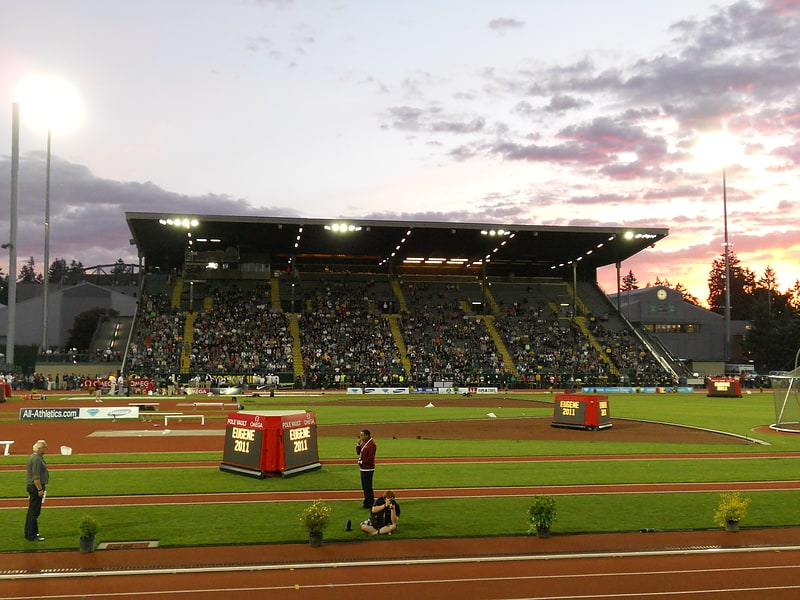
Stadium in Eugene, Oregon. Hayward Field is a track and field stadium in the northwest United States, located on the campus of the University of Oregon in Eugene, Oregon. It has been the home of the university's track and field teams since 1921, and was the on-campus home of the varsity football team from 1919 through 1966. Track and field competitions at the stadium are organized by the not-for-profit organization TrackTown USA.
Hayward Field was named after track coach Bill Hayward (1868–1947), who ran the Ducks' program from 1904 to 1947. Renovated in 2004, it is one of only five International Association of Athletics Federations Class 1 certified tracks in the United States (along with Hutsell-Rosen Track, Icahn Stadium, John McDonnell Field, and Rock Chalk Park). The elevation of Hayward Field is approximately 420 feet (130 m) above sea level and its infield has a conventional north-south orientation. The Pacific Ocean is approximately fifty miles (80 km) to the west, separated by the Coast Range.
In 2018, the stadium was demolished and rebuilt on the same site. The new stadium is financed by UO's philanthropic community, with alumnus Phil Knight as the main donor.[1]
Address: 1580 E 15th Ave, 97403 Eugene (City Central)
Skinner Butte
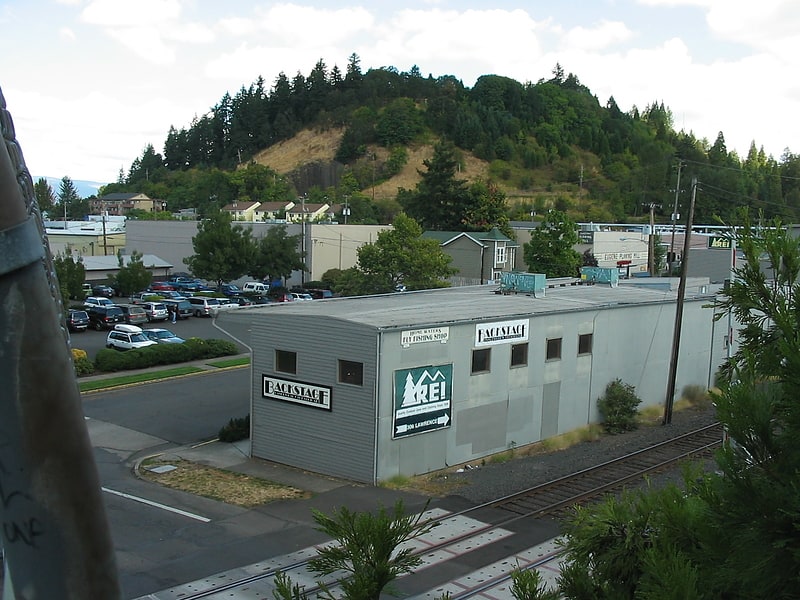
Park in Eugene, Oregon. Skinner Butte is a prominent hill on the north edge of downtown Eugene, Oregon, near the Willamette River. A local landmark, it honors city founder Eugene Skinner and is the site of the municipal Skinner Butte Park. During the early 1920s, the city's Ku Klux Klan members etched the letters "KKK" into the side of the butte and installed a cross near the top. Local Klan members were said to have burned the cross during meetings. The letters were removed and replaced with the letter "O" in the late 1920s. The cross was replaced several times since the Klan first erected it. However, the cross wasn't permanently removed until 1997.[2]
Address: 10 Cheshire Ave, 97401 Eugene (City Central)
Autzen Stadium
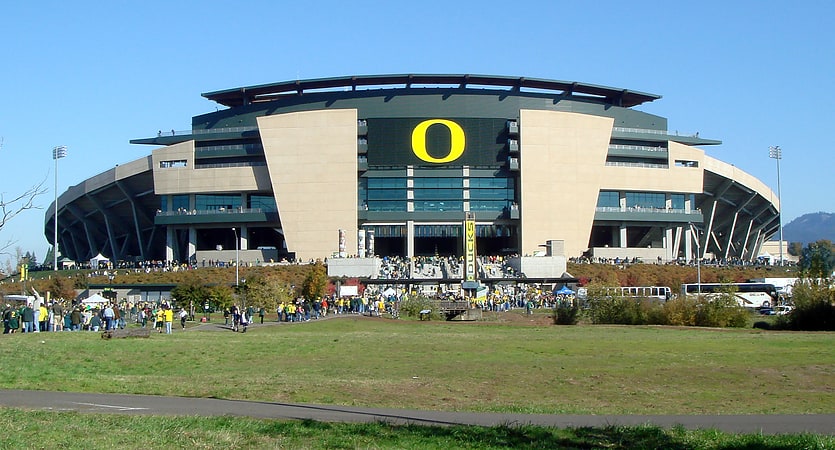
Stadium in Eugene, Oregon. Autzen Stadium is an outdoor football stadium in the northwest United States, in Eugene, Oregon. Located north of the University of Oregon campus, it is the home field of the Oregon Ducks of the Pac-12 Conference. Opened 55 years ago in 1967, the stadium has undergone several expansions. The official seating capacity is presently 54,000, however, the actual attendance regularly exceeds that figure.[3]
Address: 2700 Martin Luther King Jr Blvd, 97401-5929 Eugene (Willakenzie)
Matthew Knight Arena
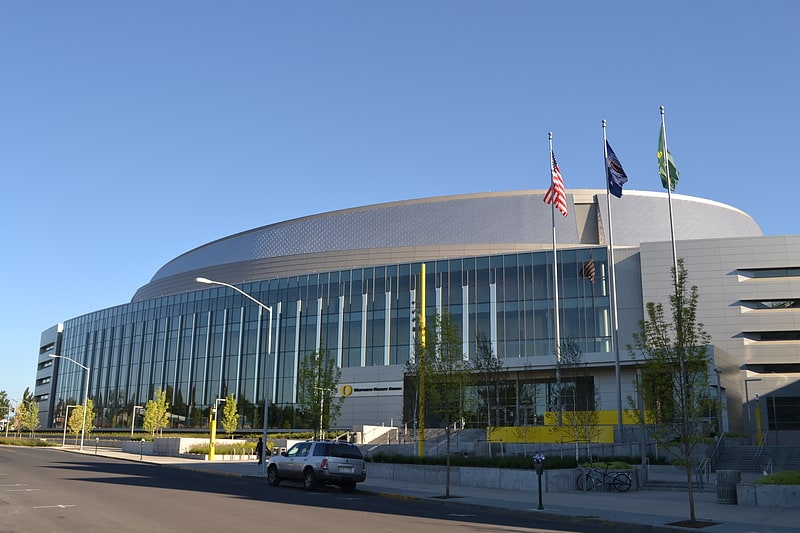
Arena in Eugene, Oregon. The Matthew Knight Arena is a 12,364-seat, multi-purpose arena in Eugene, Oregon, United States. It is home of the University of Oregon Ducks basketball teams, replacing McArthur Court. It is located on the east side of campus at the corner of Franklin Boulevard and Villard Street, a gateway to campus as people arrive from I-5. The arena was originally intended to be ready for the start of the 2010–11 basketball season, but instead opened for the men's basketball game against the USC Trojans on January 13, 2011. It is named for chief donor Phil Knight's son, Matthew Knight, who died at the age of 34 in a scuba diving accident. The arena cost $227 million and was designed as collaboration between TVA Architects of Portland and Ellerbe Becket of Kansas City, Missouri. Hoffman Construction Company of Portland was the general contractor.
The Ducks inaugurated the arena to a sold-out crowd on January 13, 2011, beating the USC Trojans, 68–62.[4]
Address: 1390 Villard St, 97403-1955 Eugene (City Central)
Jordan Schnitzer Museum of Art
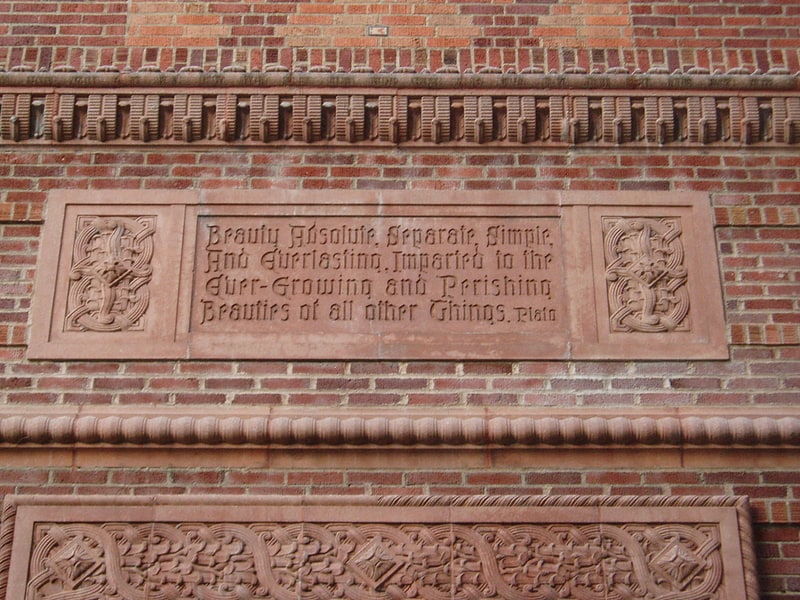
Museum in Eugene, Oregon. see also the Jordan Schnitzer Museum of Art, Washington State University, Pullman, Washington
Jordan Schnitzer Museum of Art is an art museum located on the campus of the University of Oregon in Eugene, Oregon. The original building was designed by Ellis F. Lawrence as part of his "main university quadrangle," now known as the Memorial Quadrangle. Its first Director, Asian art collector, and female museum specialist Gertrude Bass Warner also influenced the buildings design, particularly its innovative climate control measures. The museum is accredited by the American Alliance of Museums.[5]
Address: 1430 Johnson Lane, 97403 Eugene (City Central)
Kesey Square

Kesey Square, formerly known as Broadway Plaza, is a public square at the southeast corner of Broadway and Willamette Street in downtown Eugene, Oregon, in the United States. The square was renamed to commemorate novelist and countercultural figure Ken Kesey in October 2017.[6]
Address: 2 E Broadway, 97401 Eugene (City Central)
Museum of Natural and Cultural History
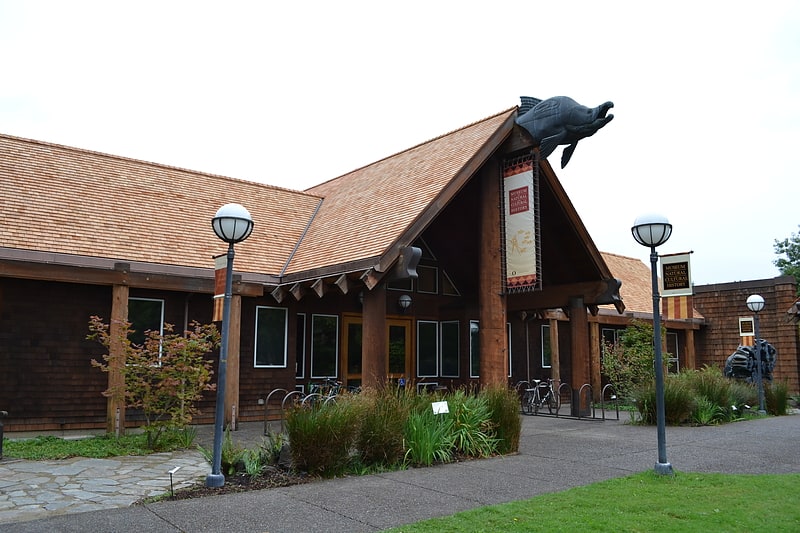
Museum in Eugene, Oregon. The University of Oregon Museum of Natural and Cultural History, commonly known as the UO Natural History Museum, is an American natural history museum at the University of Oregon in Eugene. Located near Hayward Field on the east side of the UO campus, it is the largest natural history museum between Seattle and San Francisco and a center for archaeological and paleontological research in the Pacific Northwest and the wider world. The museum headquarters and public spaces are located at 1680 East 15th Avenue in a building inspired by the design of Pacific Northwest Native longhouses.[7]
Address: 1680 E 15th Ave, 97403 Eugene (City Central)
Hult Center for the Performing Arts
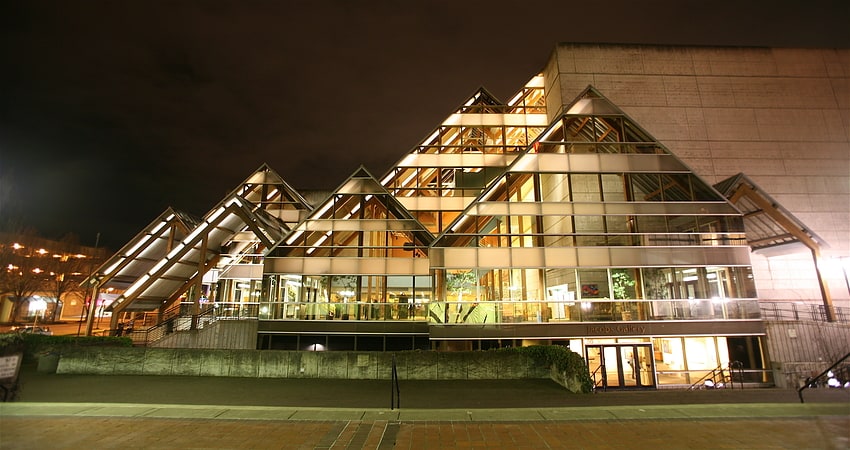
Performing arts theater in Eugene, Oregon. The Hult Center for the Performing Arts is a performing arts venue in Eugene, Oregon.
The Hult Center is located downtown on Willamette Street between 6th & 7th Avenues, adjacent to the Graduate Eugene (previously Hilton Eugene) and Conference Center. Built using funds that were approved by voters in 1978, the Hult Center and the Hilton were completed in 1982 as part of the same urban renewal project.
The Hult Center is operated by the City of Eugene and is one of two performing arts venues owned by the City. Cuthbert Amphitheater, located in Eugene's Alton Baker Park, is also owned by the City and is operated by Kesey Enterprises.
Twenty-seven architectural firms competed for the opportunity to design the Center, but in the end, the Eugene City Council awarded the contract to the New York firm of Hardy Holzman Pfeiffer Associates. The firm had previously designed the $7.5-million, 2,700-seat Minneapolis Orchestra Hall and the $13-million Boettcher Concert Hall at the Denver Center for the Performing Arts.[8]
Address: Eugene, One Eugene Center, Eugene OR, 97401
Shelton McMurphey Johnson House
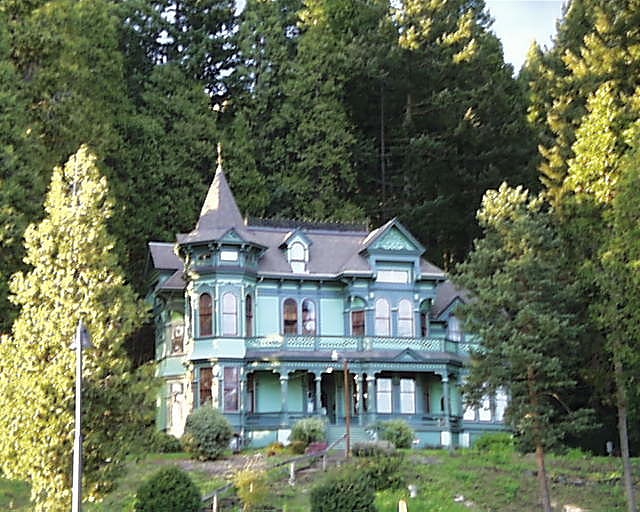
Museum in Eugene, Oregon. The Shelton McMurphey Johnson House, or Castle on the Hill, in Eugene, Oregon, United States, is a Victorian-era residence that is listed on the National Register of Historic Places. It is named for the three families who called it home over the years. The house is now open for public tours and pre-arranged private events.[9]
Address: 303 Willamette St, 97401-2600 Eugene (City Central)
Science Factory

Museum in Eugene, Oregon. The Eugene Science Center, located in Alton Baker Park in Eugene, Oregon, United States, is a science and technology center for children, families, and school groups. The 10,000-square-foot museum near Autzen Stadium features changing interactive exhibits, planetarium shows, camp programs, special events and other science and technology-related education programs. Eugene Science Center is an independent 501 non-profit organization governed by a volunteer board of directors. Its mission is: "To engage children, excite their curiosity, inspire them toward a lifetime love of science, and empower them to use science and technology to improve their communities." Eugene Science Center is the only science museum in Lane County and surrounding counties.[10]
Address: 2300 Leo Harris Pkwy, 97401-8834 Eugene (Willakenzie)
Hendricks Park

City park in Eugene, Oregon. Hendricks Park is the oldest city park in Eugene, Oregon, United States. The 78-acre park is a little over a mile away from the University of Oregon campus, and contains mature forest, a 12-acre rhododendron garden, and a native plant garden. The park is laced with trails suitable for hiking, jogging, and birding.[11]
Address: 2198 Summit Ave, 97403-2105 Eugene (South Eugene)
Eugene Masonic Cemetery
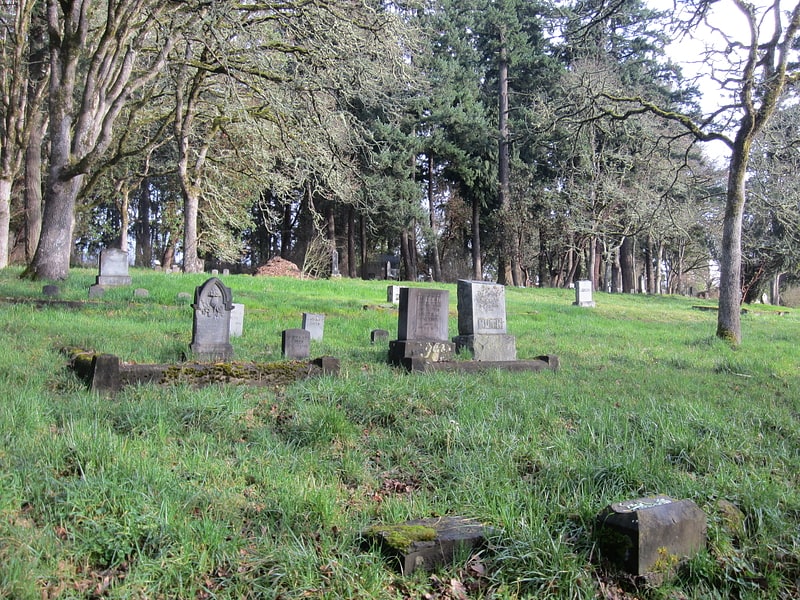
Cemetery in Eugene, Oregon. The Eugene Masonic Cemetery, the oldest chartered cemetery in Eugene, Oregon, is one of the oldest privately owned and continuously operating historic entities in Lane County. Incorporated as a burial site in 1859, the same year Oregon became a state, it occupies ten acres on a knoll in southeast Eugene, with main entrance gate at University Street and 25th Avenue. The cemetery contains Hope Abbey Mausoleum which, together with the cemetery itself, was placed on the National Register of Historic Places in 1980.
The cemetery was originally owned by Masonic Lodge No.11, but has been owned and operated since 1994 by the non-profit Eugene Masonic Cemetery Association, whose board members are volunteers. It retains "Masonic" in its name as an important historic reference, but is no longer officially affiliated with Freemasonry.
The Masonic Cemetery in Eugene, Oregon dates from 1859. It and Hope Abbey mausoleum were listed on the U.S. National Register of Historic Places in 1980.[12]
Address: 2575 University St., 97403 Eugene (South Eugene)
St. Mary Roman Catholic Church
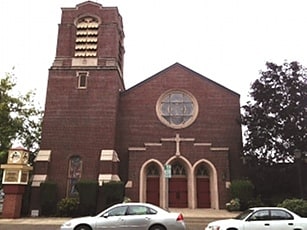
Catholic church in Eugene, Oregon. The St. Mary Roman Catholic Church in Eugene, Oregon, United States, was established in 1887. It is part of the Roman Catholic Archdiocese of Portland in Oregon.[13]
Address: 1062 Charnelton St, 97401 Eugene (City Central)
Alton Baker Park
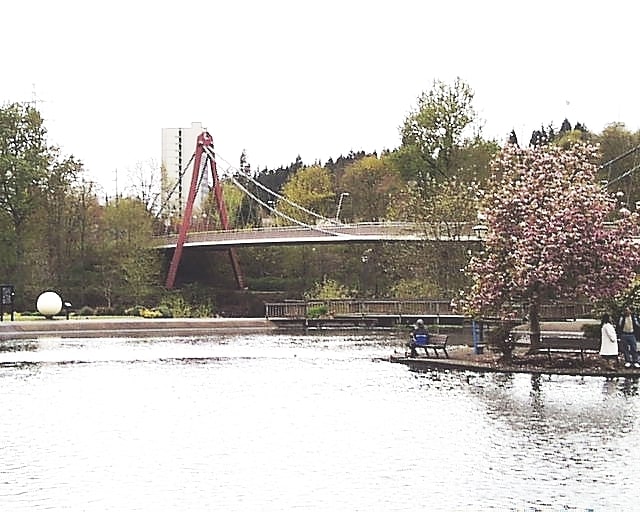
Park in Lane County, Oregon. Alton Baker Park is located in Eugene, Oregon, United States, near Autzen Stadium. It was named for Alton F. Baker Sr. the eleventh owner of Eugene's The Guard newspaper. It features duck ponds, bicycle trails, a dog park and a disc golf course, and directly touches the Ferry Street Bridge across the Willamette River.
Other amenities include the Cuthbert Amphitheater, a venue for outdoor musical and drama performances. The amphitheater is named for Fred Cuthbert, the park's designer.[14]
The Shedd Institute
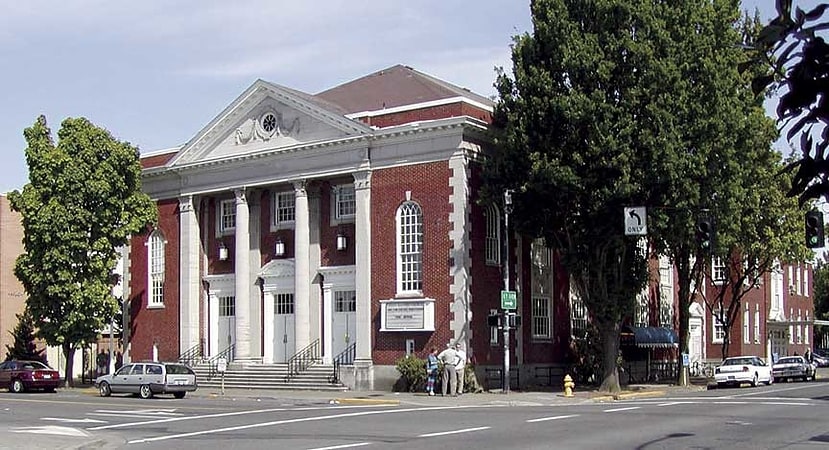
Live music venue in Eugene, Oregon. The John G. Shedd Institute for the Arts, is a performing arts company, cultural arts center, and community music school in Eugene, Oregon, United States. The Institute has three performance venues, various community meeting rooms, and extensive music education facilities. It presents annually an array of culturally diverse festivals, concert series and educational programs that focus on, but are not limited to, American music.[15]
Address: 868 High St, 97401-2726 Eugene (City Central)
Cascades Raptor Center
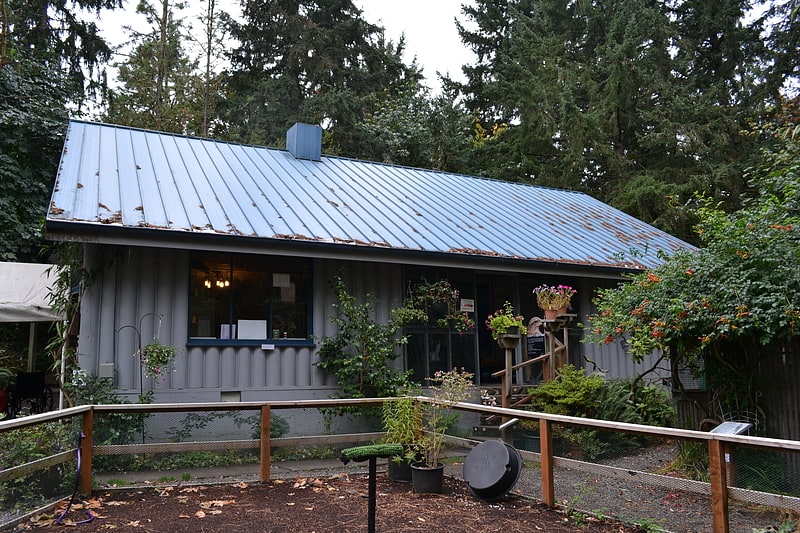
Outdoor aviaries with many birds of prey. The Cascades Raptor Center is a nature center and wildlife hospital in Eugene, Oregon that specializes in raptor rehabilitation. As of November 2020, permanent inhabitants of the center include 37 individual birds from 21 species.[16]
Address: 32275 Fox Hollow Rd, Eugene OR 97405, Eugene
McDonald Theatre
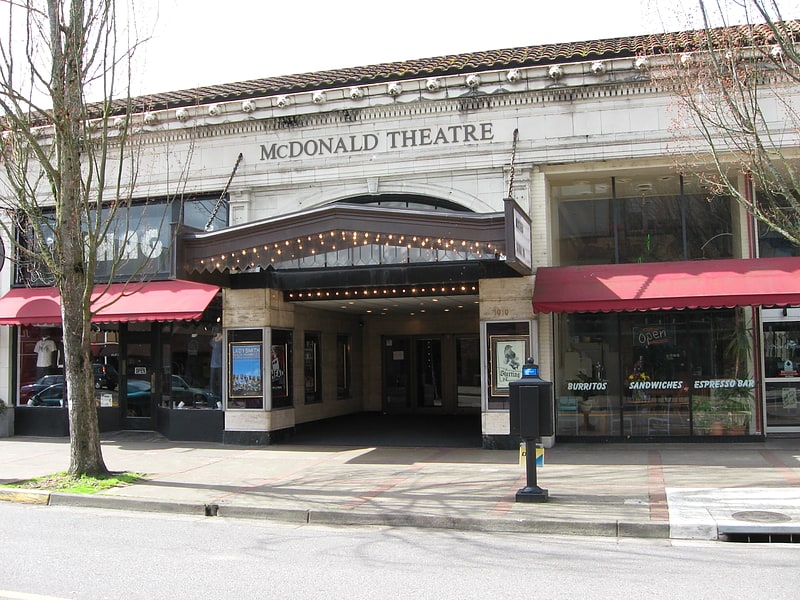
Theater in Eugene, Oregon. McDonald Theatre is a theater and music venue in Eugene, Oregon, United States. Opened in 1925 as a movie house, the building was converted to a theater for performing arts, and is still in business. The theater is listed on the National Register of Historic Places.[17]
Address: Eugene, 1010 Willamette Street
Frohnmayer Bridge
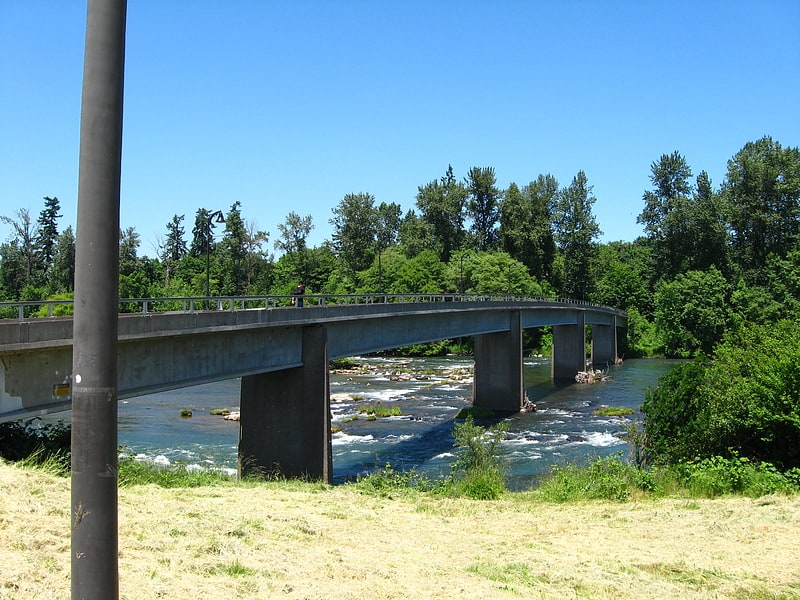
Bridge in Eugene, Oregon. The Dave and Lynn Frohnmayer Pedestrian and Bicycle Bridge, formerly and still informally known as the Autzen Footbridge, is a bicycle and pedestrian bridge across the Willamette River, located in Eugene, Oregon, in the United States. Named after former University of Oregon president David B. Frohnmayer, the bridge connects Alton Baker Park and Autzen Stadium.
The bridge was originally proposed in 1970 by the Eugene Water & Electric Board (EWEB) to carry steam between EWEB's steam plant and a commercial greenhouse near Autzen Stadium. The river's bedrock deterred installing a buried pipe. In proposing a bridge, EWEB offered the university and Lane County the option of incorporating a pedestrian bridge if they paid the extra cost.[18]
Mount Pisgah Arboretum

Arboretum in Lane County, Oregon. The Mount Pisgah Arboretum is a non-profit arboretum and botanical garden located within the Howard Buford Recreation Area, between the Coast Fork of the Willamette River and the slopes of Mount Pisgah near Eugene-Springfield, Oregon, United States.
The Friends of Mount Pisgah Arboretum was established in 1973 when it began to construct trails, build bridges, remove invasive species, and publish newsletters. Wildflower and mushroom shows were first held in 1981; staff hiring began in the early 1980s. The arboretum's original mission was to have international plantings, however most of the early international donations were moved off site. This has changed to maintaining Pacific Northwest plant communities, offer environmental education programs, and provide for public enjoyment of its site.
The arboretum includes 7 miles (11 km) of riverside trails with 23 bridges, riparian meadows, evergreen forests, a rare section of preserved oak savanna, Douglas-fir and incense-cedar forests on hillsides, a water garden, wildflower meadows, a wooded picnic area, and restrooms. The White Oak Pavilion took the place of the deteriorating quonset hut shelter in 2005.
The arboretum's habitats are home to many species of native mosses, lichens, ferns, shrubs, and wildflowers. 67 families, 231 genera, and 339 plant species have been identified on the site. Wildlife includes bats, deer, coyote, foxes, and other small mammals, the endangered western pond turtle, the sensitive species red-legged frog, tree frogs, gopher and garter snakes, and lizards. Birding is a popular activity in the arboretum, which is home to a variety of migratory and resident songbirds, raptors, and waterfowl. The arboretum publishes a bird checklist, as well as a plant checklist, to aid visitors in identifying the local species.
Parking is $4 per car and permits can be purchased at a self-service pay station.[19]
Address: 34901 Frank Parrish Rd, 97405-9673 Eugene
Eugene Pioneer Cemetery

Cemetery in Eugene, Oregon. Eugene Pioneer Cemetery is a pioneer cemetery in Eugene, Oregon, United States. It is one of the three oldest cemeteries in Eugene. It is the largest in both acreage and burials encompassing 16 acres with approximately 5,000 burials.[20]
Wayne Morse Family Farm
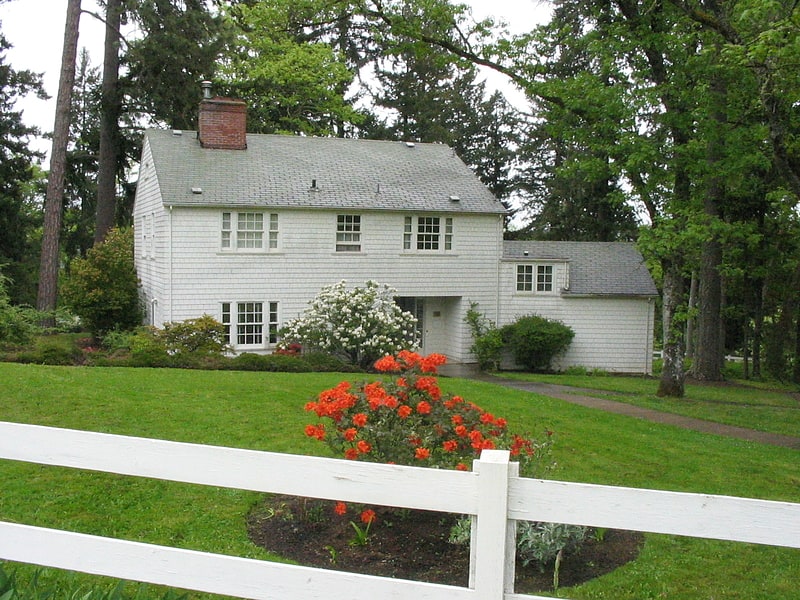
Park in Eugene, Oregon. The Wayne Morse Family Farm, a City of Eugene park, was the home of Oregon's long-time United States Senator, Wayne Morse. The 27-acre home is located in Eugene, Oregon and was originally a working farm called Edgewood Farm. Owned by the Morse family, it includes the Morse home, a natural wooded area, and an open meadow. Formerly named Morse Ranch, the park is listed on the National Register of Historic Places.[21]
Peter DeFazio Bridge

Bridge in Eugene, Oregon. The Peter DeFazio Bridge is a bicycle and pedestrian bridge located in Eugene, Oregon, that crosses the Willamette River. The bridge was completed in 2000 and cost $2.8 million.[22]
Address: Coburg Road, 97401 Eugene (City Central)
Oregon Air and Space Museum
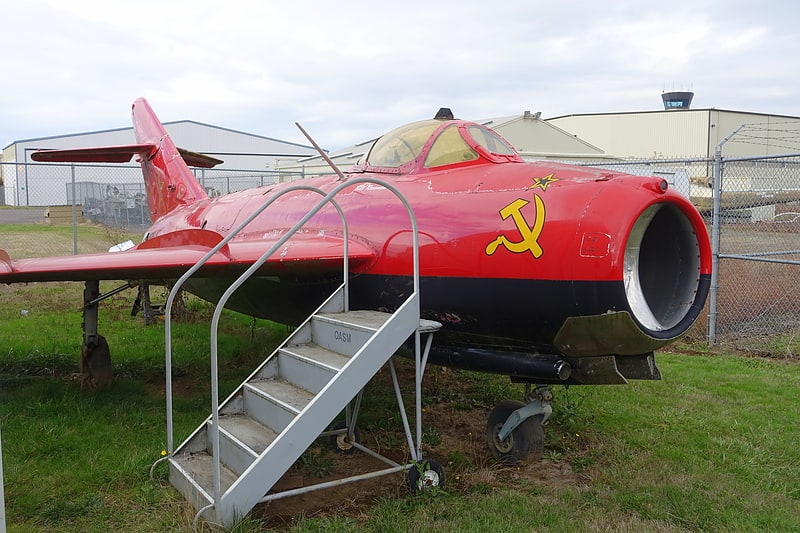
Museum in Lane County, Oregon. The Oregon Air and Space Museum, located on the grounds of the Eugene Airport in Eugene, Oregon, holds a collection of historic aircraft and spacecraft.[23]
Address: 90377 Boeing Dr, 97402-9536 Eugene
Maude Kerns Art Center
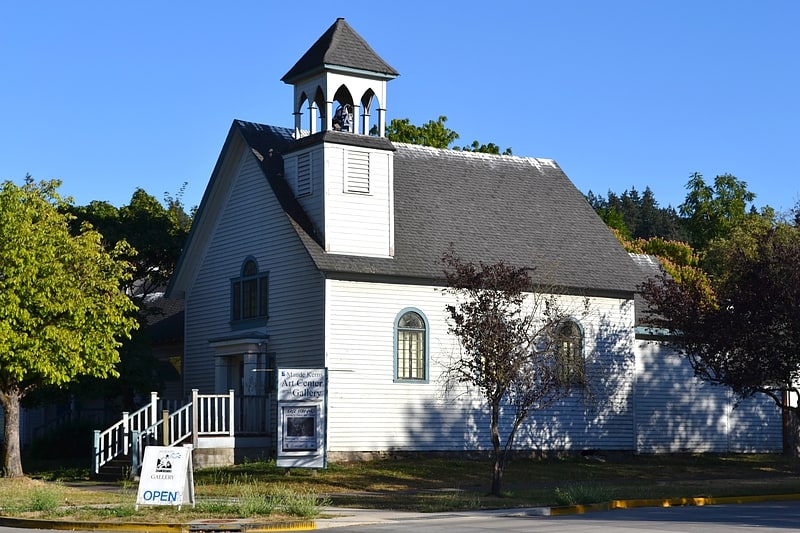
Maude Irvine Kerns was an American artist and art educator, known for her avant-garde paintings. Her works were exhibited at the Guggenheim Museum, National Gallery of Art, and the Salon des Réalités Nouvelles, and earned Kerns considerable notoriety among the abstract art movement in New York. She later taught art at the University of Oregon as well as at high schools in Corvallis and Seattle, Washington before her death in 1965.[24]
Address: 1910 E 15th Ave, 97403-2007 Eugene (South Eugene)
Ferry Street Bridge
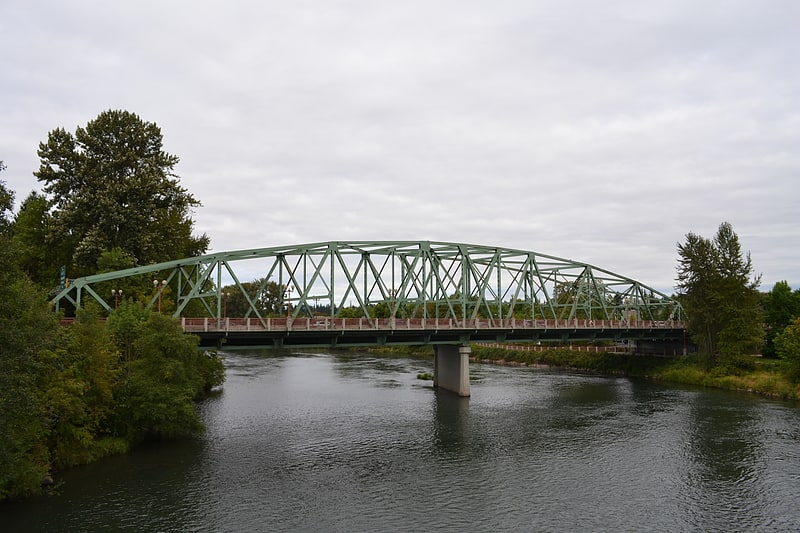
Truss bridge in Eugene, Oregon. The Ferry Street Bridge is a bridge that spans the Willamette River in Eugene, Oregon, United States. It is located near downtown Eugene, where the city's founder Eugene Skinner once operated a ferry service. The bridge is at Willamette river mile 182.2, and is a block west of the north terminus of the actual Ferry Street. The neighborhood immediately north of the Willamette River near the bridge is often called the "Ferry Street Bridge area."
Ferry Street Bridge carries Coburg Road in four lanes which connects the small city of Coburg to central Eugene. The bridge is approximately 800 feet (240 m) long, though the river width is only 300 feet (91 m) here, Club Road passes under the Ferry Street Bridge on the north shore along with a bike path; another bike path passes under the bridge on the south shore where it enters the east end of Campbell Park.
The bridge is on the shortest motor vehicle route between the University of Oregon main campus and Autzen Stadium.
The Peter DeFazio Bridge is located approximately 800 feet (240 m) upstream.[25]
Eugene Public Library
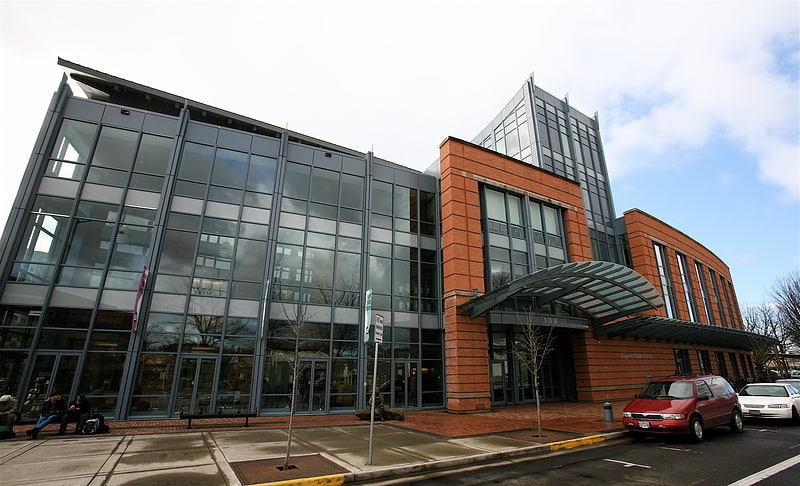
Public library. The Eugene Public Library is a municipal public library in Eugene, Oregon, United States. It has been in four different buildings since 1898.[26]
Address: 100 W 10th Ave, 97401-3035 Eugene (City Central)
Spencer Butte

Spencer Butte is a prominent landmark in Lane County, Oregon, United States, described in the National Geodetic Survey as "a prominent timbered butte with a bare rocky summit" on the southern edge of Eugene, with an elevation of 2,058 feet. Spencer Butte is accessible from Spencer Butte Park and has several hiking trails to the summit. The tree cover on the butte is predominantly Douglas fir, however the butte is treeless at its summit. The butte is the tallest point visible when looking south from downtown Eugene.[27]
Address: South Willamette Street, Eugene
Whilamut Passage Bridge

Bridge in Lane County, Oregon. The Whilamut Passage Bridge is a pair of bridges across the Willamette River in Eugene, Oregon, U.S. The west span was completed in 2011. The east span was completed and opened in August 2013. They carry Interstate 5 traffic and replaced an earlier bridge completed in 1961. Construction on the bridges began in 2009 and cost $204 million.[28]
Knickerbocker Bicycle Bridge
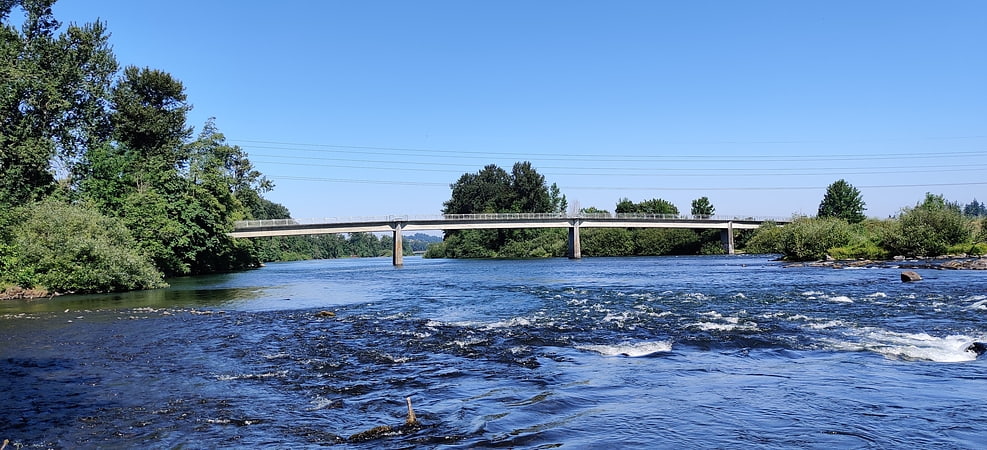
Bridge in Eugene, Oregon. Knickerbocker Bicycle Bridge is a bridge across the Willamette River in Eugene, Oregon, United States. The bridge was dedicated in 1980.
The bridge was originally constructed to carry a Eugene Water & Electric Board water main for $330,000. The city and county added the bridge deck, rails, and approaches for $110,000.
The bridge is named for Willie Knickerbocker (1868–1960), "The Father of Bicycling in Eugene".[29]
University of Oregon
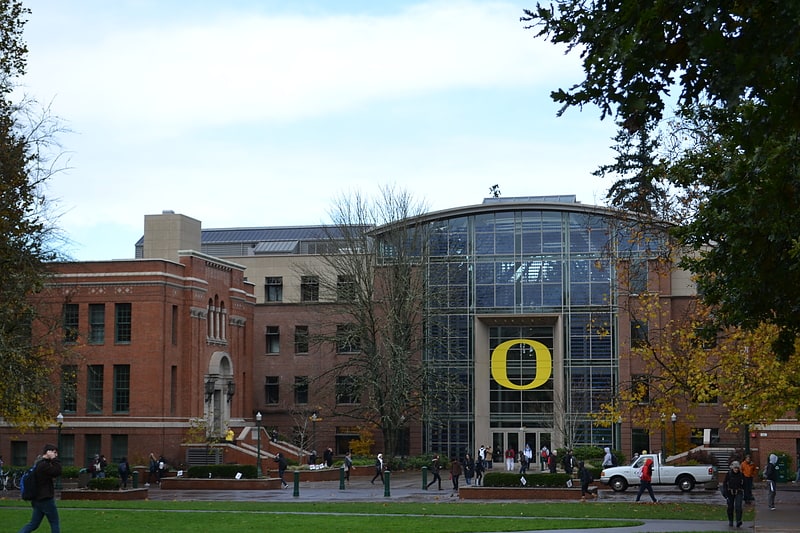
Public university in Eugene, Oregon. The University of Oregon is a public flagship research university in Eugene, Oregon, United States. Founded in 1876, the institution's 295-acre campus is along the Willamette River. Since July 2014, UO has been governed by the Board of Trustees of the University of Oregon. The university is classified among "R1: Doctoral Universities – Very high research activity" and has 19 research centers and institutes. UO was admitted to the Association of American Universities in 1969.
The University of Oregon is organized into five colleges (Arts and Sciences, Business, Design, Education, and Honors) and seven professional schools (Accounting; Architecture and Environment; Art and Design; Journalism and Communication; Law; Music and Dance; and Planning, Public Policy and Management) and a graduate school. Furthermore, UO offers 316 undergraduate and graduate degree programs. Most academic programs follow the 10 week Quarter System.
UO student athletes compete as the Ducks and are part of the Pac-12 Conference in the National Collegiate Athletic Association (NCAA). With eighteen varsity teams, the Oregon Ducks are best known for their football team and track and field program.[30]
Address: 1585 E 13th Ave, Eugene (City Central)
Knight Library

University library in Eugene, Oregon. Knight Library is the main facility of the University of Oregon's library system. It is located on the university's campus in Eugene, Oregon, United States. The library design is emblematic of the architecture of the university's older buildings, and it serves as a hub of student activity. As of 2008 it has a collection of more than 3 million volumes. The library also holds collections of primary sources such as photographs and manuscripts on various topics at the Special Collections & University Archives. It is also a depository for the Federal Depository Library Program.[31]
Address: 1501 Kincaid St, 97403 Eugene (City Central)
Eugene Station

Bus station in Eugene, Oregon. Eugene Station is the primary bus station and terminus in Eugene, Oregon, United States, serving the buses of the Lane Transit District. Construction began with the official groundbreaking in 1996 and the station opened in April, 1998. The station covers most of a city block, and includes a clock tower featuring glass pyramids and arches inset with colorful glass blocks created by local glass artist John Rose. Bus lines include LTD's EmX service.[32]
Wayne Lyman Morse United States Courthouse
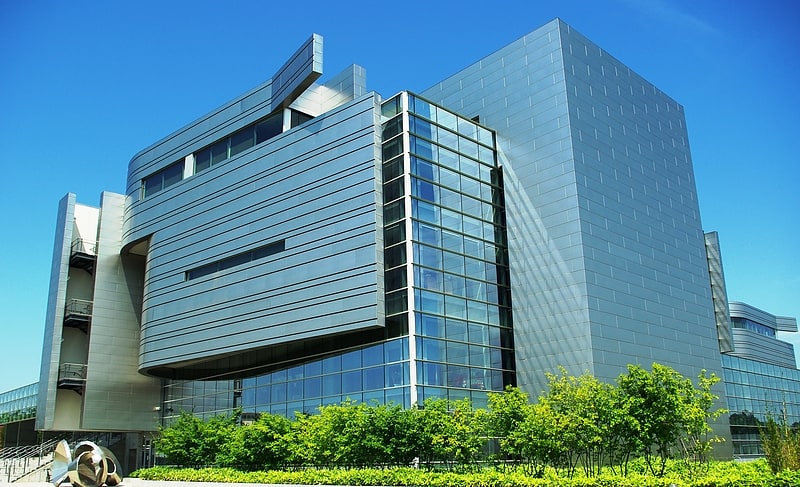
Courthouse. The Wayne Lyman Morse United States Courthouse is a federal courthouse located in Eugene, Oregon. Completed in 2006, it serves the District of Oregon as part of the Ninth Judicial Circuit. The courthouse is named in honor of former U.S. Senator Wayne Morse who represented Oregon for 24 years in the Senate and was a Eugene area resident. Located in downtown Eugene, the building overlooks the Willamette River.
Standing six stories tall, the 266,742-square-foot (24,781.1 m2) building contains six courtrooms as well offices for the courts and other federal agencies such as the United States Marshals Service. The courthouse also has offices for Oregon's two U.S. Senators and for the U.S. Representative in the district. Designed by architect Thom Mayne, the building has won several design awards and earned Leadership in Energy and Environmental Design (LEED) Gold certification for energy efficiency. The courthouse was the first new federal courthouse to earn LEED Gold certification.[33]
Park Blocks
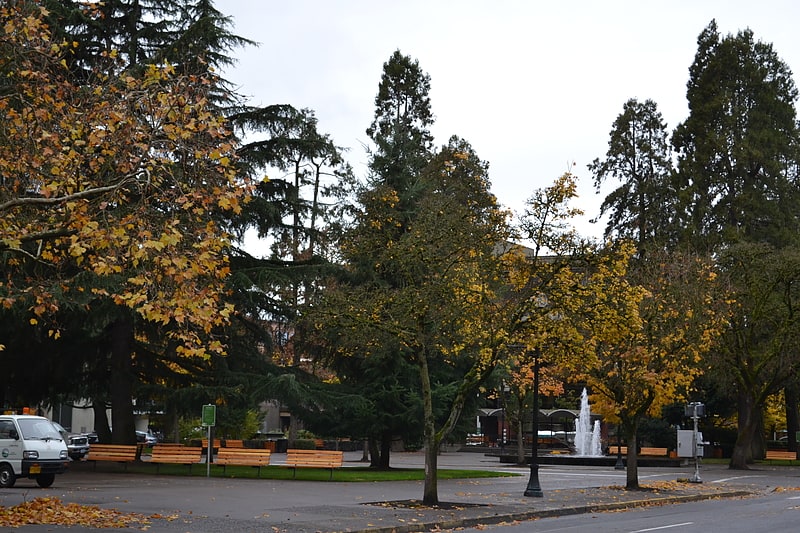
Park in Eugene, Oregon. The Park Blocks, formerly known as Hitching Post Square, are an urban plaza in Eugene, Oregon, United States. Tom Hardy's untitled fountain and sculpture and Jan Zach's Three Standing Forms (1959 are both installed in the park.[34]
Untitled
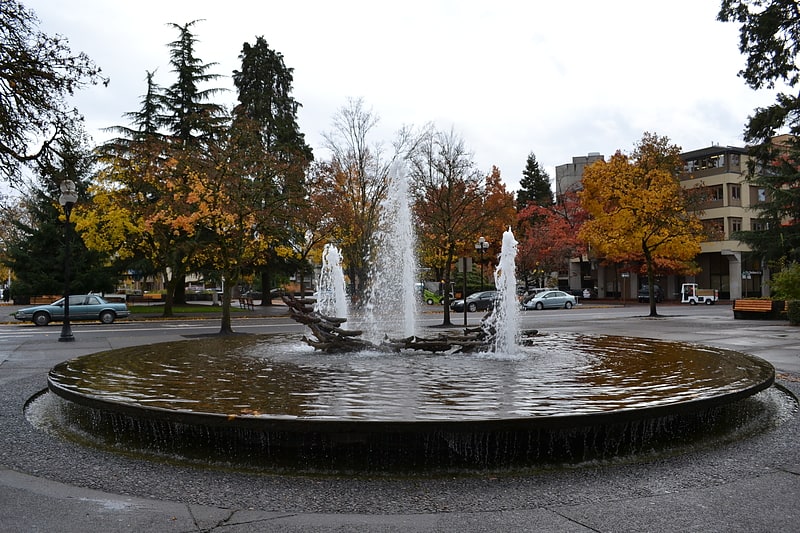
Sculpture created in 1952. Untitled is an outdoor 1952 fountain and sculpture by Tom Hardy, installed at the Park Blocks in Eugene, Oregon, United States.[35]